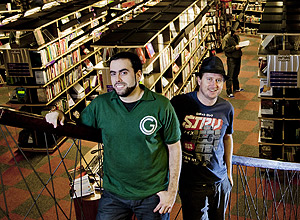Latest Photo Galleries
Brazilian Markets
12h54 Bovespa |
-0,08% | 124.629 |
16h43 Gold |
0,00% | 117 |
12h50 Dollar |
+0,34% | 5,1665 |
16h30 Euro |
+0,49% | 2,65250 |
ADVERTISING
Book deconstructs myths of Latin America and fights the "leftist" vision of the facts
08/30/2011 - 11h02
Advertising
CARLOS MESSIAS
MARCO RODRIGO ALMEIDA
FROM SÃO PAULO
The journalist Leandro Narloch discovered a gold mine - and a source of controversy - with his first book "The Politically Incorrect Guide to the History of Brazil" (Leya), published in 2009.
A caustic portrayal of the country's myths, it sold over 200 thousand copies and infuriated historians all over Brazil.
Its sequel, "The Politically Incorrect Guide to Latin America", written with another journalist, Duda Teixeira, is now in bookstores with the promise of more controversy.
The pair tries to demystify the main heroes of the Latin American left, like the Mexican revolutionary Pancho Villa, the Chilean socialist president Salvador Allende and the Argentinean guerilla Che Guevara.
| Carlos Cecconello/Folhapress |
 |
| The writers Leandro Narloch(with a hat) and Duda Teixeira |
"We took the controversy into consideration, but the main purpose was to point out what is not in the history books," says Duda Teixeira, 36.
The authors researched more than one hundred titles, but no travel was undertaken in the production of this work.
The editing of the book is didactic, with short chapters and colloquial language, highlighting the "hairiest" subjects about each character.
"Narloch masters the technique of calling attention to the relevant historical facts," says Laurentino Gomes, author of the best-seller "1808" (Planeta).
Narloch himself, 33, doesn't hide his intentions regarding the work. "The book was designed to be a best-seller. If it wasn't to make money, I'd be home playing video games."
None of these controversies (read at the side) became, in fact, new. What made the book famous is the admittedly partial and satirical tone used by the authors.
Both call themselves "right wing liberals". They say that the "Guide" is a counterpoint to the leftist mentality that they believe dominated the teaching of history in Brazil between 1960 and 1980.
"It is not a historical guide. It is politically incorrect. We only show the uncomfortable side of historical heroes," says Narloch.
This is, rightly, the main criticism of the work. According to Maria Ligia Prado, history professor at USP, the authors take "phrases at random, removing them from their historical context, giving them positive or negative value without proper explanation, which limits their understandability."
But the historian José Murilo de Carvalho sees a positive side to the provocative revisionism of the "Guide".
He says that until the 1990's, the Marxist storyline was predominant in history textbooks. "Today there are a greater variety of interpretations. This dynamic is good, because it creates a debate." Carvalho hasn't read the new "Guide" but considers the first good work. "It is current. It isn't a joke."
CHILE
In addition to the criticism of the concept of the work, the "Guide" is also a target of challenges related to factual data. Oscar Pilagallo, author of "The History of Brazil in the 20th Century" says it is incorrect that the CIA was active in Chile only between 1962 and 1970, in other words, before the coup in 1973 that overthrew Allende.
"After this [1970], the CIA only changed its mode of operation and went on to destabilize the Chilean economy, financing the fateful strike by truckers in 1972. The information is contained in the book "Formula for Chaos" by Moniz Bandeira, that Narloch uses in his research."
Duda Teixeira, on the other hand, says that "there is no evidence, neither in Moniz Bandeira's book nor elsewhere, that the CIA orchestrated the coup, gave the order to carry it out or contributed to it."
Correct or not, the authors have already cashed in on the controversy. The new "Guide" has an initial printing of 100 thousand copies, while the national average is between 3,000 and 5,000.
In 2013, Narloch intends to end the series by deconstructing myths of world affairs. "My great dilemma as a writer is not knowing how dependent I am on this title," recognizes Narloch.
Translated by DAVE WOLIN



